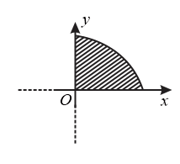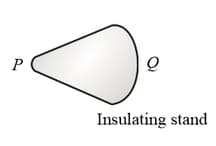A uniform surface charge of density is given to a quarter of a disc extending up to infinity in the first quadrant of plane. The centre of the disc is at the origin . Find the -component of the electric field at the point and the potential difference between the points and .



Important Questions on Electric Potential
Electric potential is given by . The electric force acting on point charge placed on origin will be?
The figure gives the electric potential as a function of distance through five regions on axis. Which of the following is true for the electric field in these regions?

Figure shows a charged conductor resting on an insulating stand. If at the point the charge density is , the potential is and the electric field strength is , what are the values of these quantities at point ?

The electrostatic potential on the surface of a charged conducting sphere is . Two statements are made in this regard
at any point inside the sphere, the electric field intensity is zero.
at any point inside the sphere, the electrostatic potential is .
Which of the following is a correct statement?
